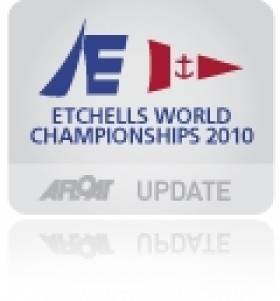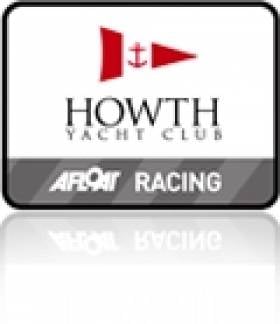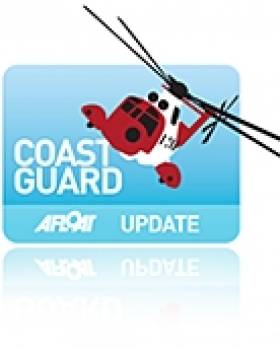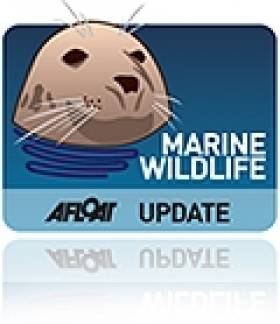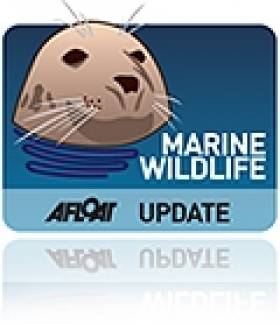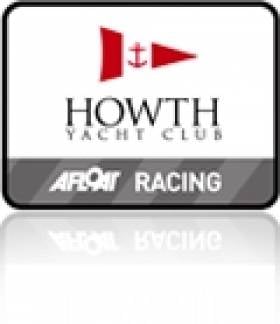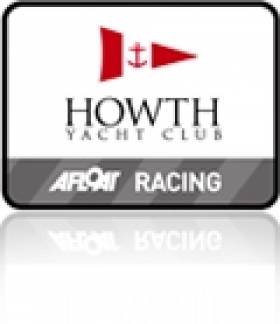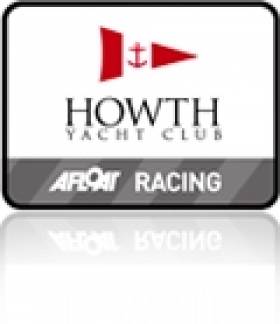Displaying items by tag: Howth
Etchells Worlds Howth, All Three Videos HERE!
Howth got a makeover for last week's Etchells World Championships and the video clips below show the fruit of all the hard work after a successful championship there.
Shadowfax Beats Puffin in Howth Squib Race
Howth Coastguard Work Features in 'The Irish Times'
Irish Times reporter Laurence Mackin spent a day with the Howth Coast Guard, and discovers their vital, voluntary work can be distressing as well as rewarding. His feature piece is well worth a read and is published HERE.
Since the first report of the Humpback whale off Howth, north Co Dublin, on Thursday, the first sighting in the area in almost 20 years, several other eyewitness reports are surfacing too. The sitings are among a handful of validated recordings of the species in Irish waters over the past century.
A 10-year-old boy who was taking part in a Howth YC sailing course was afloat when the mammal surfaced on Thursday afternoon. The whale swam between the rescue boat and the young sailor as he waited to be picked up by an instructor.
Earleir this week Skerries Sailing Club spotted the humpback on Wednesday evening when preparing for its evening race.. "The whale was just astern of the committee boat which was anchored, said one official.
"The whale remained in close proximity to the boat for about 20-30 minutes and came to within touching distance of the boat," he added.
The mammal has been photographed within metres of the Cardinal marker off Howth Head, between Ireland's Eye and Howth harbour.
The photographer, Seán Pierce of Shearwater Sea Kayaking told reporters: "It stayed around Cardinal Mark off Howth for over two hours . . . lolling about pushing [its] head into trailing weed and perhaps scratching itself." he told the Irish Times.
The mammal has a preference for shallow coastal waters.
First Humpback Whale Spotted off Howth in 20 Years
A Hump Back Whale was spotted off Howth head, Co. Dublin this afternoon by local canoeists. It is the first reported sighting in the Eastern Irish Sea in over 20 years according to the Irish Whale and Dolphin Group (IWDG) who have issued an appeal to mariners to maintain a 100 metre distance if the mammal is sited again.
IWDG received an image from Sean Pearse of Shearwater Sea kayaking, confirming the species. The animal, adult in size, was photographed within metres of the Cardinal marker off Howth Head, between Howth harbour and Ireland's Eye this afternoon.
The IWDG have alerted NPWS and local cetacean recorders and Brendan Price of the Irish Seal Sanctuary. Although the image taken by Sean confirms its species, it is too distant to match this individual with any of the existing 11 humpback whales currently on the Irish Humpback Whale Catalogue (link below).
The IWDG say:
"If fortunate enough to re-locate this whale, we'd ask all mariners to note Marine Notice 15 which protects these endangered marine mammals from harrassment from boats. They also have full protection under Irish and EU legislation. Boats should maintain a 100m distance and keep speeds to less than 7 knots, do not cross the animals path, and please maintain a parallel course with the whale if travelling with it.
IWDG would really appreciate any images especially of the whale's ventral surface of the tail flukes or dorsal fin. These images may help us match this whale with others on the Irish catalogue or with the North Atlantic Humpback Whale catalogue which currently has over 5,500 recognisable individuals which can be matched by their unique scarring on their flanks or pattern on their flukes."
More on the IWDG website HERE.
Youtube video below from a poster who spotted a humpback whale close offshore at Hook head Co. Wexford 26th January 2010.Lambay Race Enjoys Sunshine and North-Westerly Winds
The 160 entries – something of a sailing record in recent times – for this year’s Lambay Race – sponsored by Electro Automation Group in Howth Yacht Club - enjoyed a superb day afloat, basking in sunshine as they worked their way through light to moderate north-westerly winds around the island and back to their respective finishes. Race photos from Gareth Craig on the Afloat gallery here.
A number of classes had shortened courses and the dying wind saw 30 boats failing to finish. Visiting boats represented almost one-third of the total entry and they went home with nearly half of the divisional honours.
It was a good day for Paul O’Higgins’ ‘Rockabill V’ from the National YC which enjoyed success on the double, winning Class 1 on both IRC and ECHO handicaps, with the IRC win a matter of 7 seconds on corrected time from HYC’s ‘Crazy Horse’ (Norbert Reilly).
For once, it was not the multiple National Champion boat ‘Kinetic’ at the front of the Class 2 fleet but it was a very tight affair between two other HYC boats. ‘MiniMumm’ (Cobbe/McDonald) was a mere 40 seconds ahead on water (but 1.25 minutes corrected on IRC) of ‘Superhero’ (Byrne/Banahan) but enjoyed a much more emphatic win on ECHO by 8 minutes. Dave Cullen’s ‘King One’, third on both handicaps, took the IRC Restricted prize.
The biggest class in the regatta was the 28-boat fleet in Class 3 which was dominated on the water by two visiting J24s – ‘Hard on Port’ (Flor O’Driscoll, RSt.GYC) and ‘Scandal’ (Brian McDowell, MYC) and while the Dun Laoghaire boat was a comfortable winner, it was Basil McMahon’s ‘Holly’ which came through to take 2nd on IRC and also win on ECHO.
It was another southside entry, ‘Orna’ (P.Dilworth, National YC) which showed the way in emphatic fashion in the White Sail A Division, winning IRC by a massive 11 minutes corrected and ECHO by a more modest 1.35, both times ahead of Kieran Jameson’s ‘Changeling’. Local honour was restored in the White Sail B Division with ‘Flashback’ (Gregory/Breen), with a good win on IRC and a narrow one (5 seconds) on ECHO ahead of Charlie Boyle’s ‘On the Rox’ which had the consolation of taking the HPH prize.
The one-design classes had disappointing fleets compared to the cruisers but that didn’t mean any lack of competition. Seven E-boats travelled from Clontarf for the event and it was ‘OctopussE’ (P.O’Neill) which headed the race by an impressive 7 minutes from ‘Eagle Eye’ (O’Hara/Smith).
Only four Etchells made the starting line and unsurprisingly, the O’Grady/reilly partnership on ‘Kootamundra’ won by over 5 mnutes from runner-up ‘Northside Dragon’ (D. McManus). Seven 31.7s, representing four different clubs, saw a double whammy for Royal Irish visitor ‘Attitude’ (D.Owens), just ahead of HYC’s ‘C’Est la Vie’ (Flannelly & Others).
Nine Ruffians came from Dublin Bay and after 4 hours racing, only 1 minute separated ‘Shillelagh’ (Berber/Caldwell, NYC) and ‘Shannagh’ (S.Gill (RSt.GYC) while of the five Squibs in action, only ‘Puffin’ (Emer Harte) and ‘Pot Black’ (the McMurtrys) managed a finish and in that order too, both on scratch and HPH. Peter Courtney’s ‘Oona’ headed the Howth 17s’ fleet by three minutes from ‘Rita’ (Lynch/Curley) while ‘Rosemary’ (Curley/Jones) enjoyed handicap success.
The exception to the small one-design numbers was inevitably the Puppeteers who managed to get 17 boats on the starting line and the conditions were clearly to the liking of Alan Pearson and crew on ‘Trick or Treat’ because their 4 minute margin over ‘Harlequin’ (Clarke/Egan) on the water translated into a 4-second handicap win over ‘Cloud 9’ (C.Feely)
The Lambay Race Committee was chaired by James Markey, who was delighted that entries exceeded expectations, and the sponsors were Electro Automation Group, a leading specialist in such areas as automated car park systems, gate and door access control systems, and intelligent transportation systems.
HOWTH YACHT CLUB. LAMBAY REGATTA (RACE) 12/06/2010 Class 1 IRC: 1, Rockabill V P O'Higgins NYC; 2, Crazy Horse N Reilly HYC; 3, Pretty Polly C Horrigan NYC; Class 1 ECHO: 1=, Rockabill V P O'Higgins NYC; 1=, Rollercoaster C & P Power-Smith RStGYC; 3, Raptor Hewitt/Others RIYC; Class 2 IRC: 1, MiniMumm Cobbe/McDonald HYC; 2, Superhero Byrne/Banahan HYC; 3, King One D Cullen HYC; Class 2 ECHO: 1, MiniMumm Cobbe/McDonald HYC; 2, Superhero Byrne/Banahan HYC; 3, Dochas J Molohan HYC; Class 2 IRC RESTRICTED: 1, King One D Cullen HYC; 2, Toughnut D Skehan HYC; 3, Bendemeer Casey/Power RStGYC; Class 3 IRC: 1, Hard on Port F O'Driscoll RStGYC; 2, Holly B MacMahon HYC; 3, Scandal B McDowell MYC; Class 3 ECHO: 1, Holly B MacMahon HYC; 2, Saki McCormack/Ryan RIYC; 3, Hard on Port F O'Driscoll RStGYC; First 31.7 SCRATCH: 1, Attitude D Owens RIYC; 2, C'est la Vie Flannelly/Others HYC; 3, Magic D O'Sullivan RIYC; First 31.7 ECHO: 1, Attitude D Owens RIYC; 2, C'est la Vie Flannelly/Others HYC; 3, Bluefin Two M & B Bryson NYC; Puppeteer SCRATCH: 1, Trick or treat A Pearson HYC; 2, Harlequin Clarke/Egan HYC; 3, Eclipse A & R Hegarty HYC; Puppeteer HPH: 1, Trick or treat A Pearson HYC; 2, Cloud 9 C Feely HYC; 3, Nefertari Morgan/Murray HYC; Squib SCRATCH: 1, Puffin E Harte HYC; 2, Pot Black R & I McMurty HYC; Squib HPH: 1, Puffin E Harte HYC; 2, Pot Black R & I McMurty HYC; 17 Footer SCRATCH: 1, Oona P Courtney HYC; 2, Rita Lynch/Curley HYC; 3, Rosemary Curley/Jones HYC; 17 Footer HPH: 1, Rosemary Curley/Jones HYC; 2, Echo B & H Lynch HYC; 3, Pauline O'Doherty/Ryan HYC; Etchells SCRATCH: 1, Kootamundra O'Grady/Reilly HYC; 2, Northside Dragon D MacManus HYC; 3, Jabberwocky S Knowles HYC; E Boat SCRATCH: 1, OctopussE P O'Neill CY&BC; 2, Eagle Eye O'Hara/Smith CY&BC; 3, Aoife B Linnane CY&BC; Ruffian 23 SCRATCH: 1, Shillelagh Berber/Caldwell NYC; 2, Shannagh S Gill RStGYC; 3, Diane 2 A Claffey RStGYC; SB 3 SCRATCH: 1, Shockwave E Quinlan HYC; White Sail A IRC: 1, Orna P Dilworth NYC; 2, Changeling K Jameson HYC; 3, Empress 111 T FitzPatrick HYC; White Sail A ECHO: 1, Orna P Dilworth NYC; 2, Changeling K Jameson HYC; 3, Empress 111 T FitzPatrick HYC; White Sail B IRC: 1, Flashback Gregory/Breen HYC; 2, On the Rox C & J Boyle HYC; 3, Brazen Hussy Stirling/Barry HYC; White Sail B HPH: 1, On the Rox C & J Boyle HYC; 2, Brazen Hussy Stirling/Barry HYC; 3, Alphida H Byrne HYC; White Sail B ECHO: 1, Flashback Gregory/Breen HYC; 2, On the Rox C & J Boyle HYC; 3, Mac Magic D & P McCabe HYC
Oona Sets Light Air Pace in Howth Yacht Club
Oona (P. Courtney) continued to set the pace at Howth Yacht Club racing last night with a win in the scratch division of the Howth 17 class. Winds were light but sufficient for racing. Second was Leila (R Cooper) and Rosemary (Curley/Jones) third in the 100 year old class. Full Howth Yacht Club Tuesday and Saturday and Tuesday series results below:
TUE + SAT SERIES 1 (RACE) 01/06/2010 17 Footer SCRATCH: 1, Oona P Courtney; 2, Leila R Cooper; 3, Rosemary Curley/Jones; 17 Footer HCAP: 1, Rosemary Curley/Jones; 2, Anita Cassidy/Young; 3, Leila R CooperTUESDAY SERIES 1 (RACE) 01/06/2010 Puppeteer SCRATCH: 1, Trick or Treat A Pearson; 2, Ibis G May; 3, Mojo Stanley/Callen; Puppeteer HPH: 1, Trick or Treat A Pearson; 2, Flycatcher Wright/Dillon; 3, Gannet T Chillingworth; Squib SCRATCH: 1, Whipper Snapper M Cantwell; 2, Kerfuffle J & H Craig; 3, Chatterbox J Kay; Squib HPH: 1, Whipper Snapper M Cantwell; 2, Kerfuffle J & H Craig; 3, Chatterbox J Kay; Etchells SCRATCH: 1, Lambay Rules L Dillon; 2, Kootamundra Wattle O'Grady/Reilly; 3, Fetching Quinn/O'Flaherty; SB3 SCRATCH: 1, Sin a Bhuifl Guinness/Costigan; 2, Lia D Barry; 3, Shockwave E Quinlan
Electro to Sponsor Howth Yacht Club Lambay Races
The annual Howth Yacht Club Lambay Race - Howth Regatta - is to be called the Electro Lambay Race following confirmation of sponsorship by Electro Automation Group, widely regarded as Ireland's premier automation specialist and an international leader in such areas as automated car park systems, gate and door access control systems, and intelligent transportation systems.
The race takes place on June 12 and online entry is available now. (see below)
Operating from headquarters in Damastown, near Mulhuddart, Electro was established in 1984 and now has operations in Lisburn, Galway, the UK, and Germany. The Electro brand is synonymous with advanced technology and service reliability across a wide range of products that control movements of personnel and vehicles, automatic gates and bollards, doors and barriers, hands-free access control, under-vehicle surveillance and CCTV security.
The Electro sponsorship will include a significant input into the 'family day' theme of this year's sailing which is expected to attract around 140 boats and over 1,000 sailors and visitors.
New Adult Sail Training Programme in Howth
The country's biggest club, Howth Yacht Club, has launched an adult Sail Training Programme to introduce beginners to the sport at the north Dublin Club. The course also allows newcomers to avail of all Howth Yacht Club's facilities for €240. The course takes place in late May/Early June. More details (click here) or call 01 8322141.


























